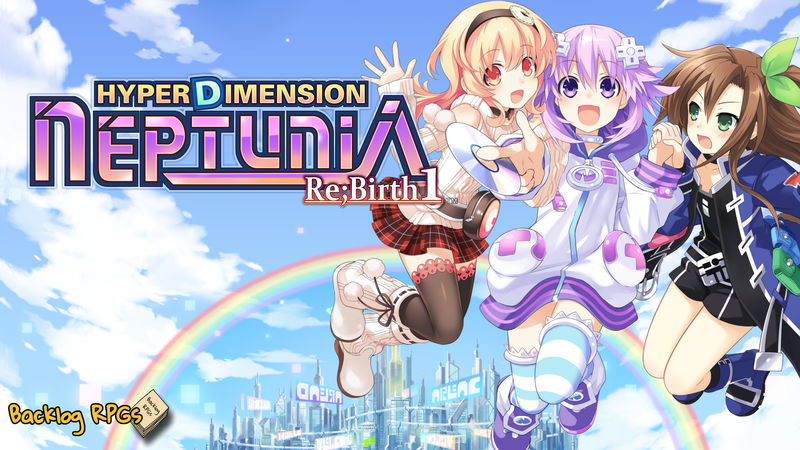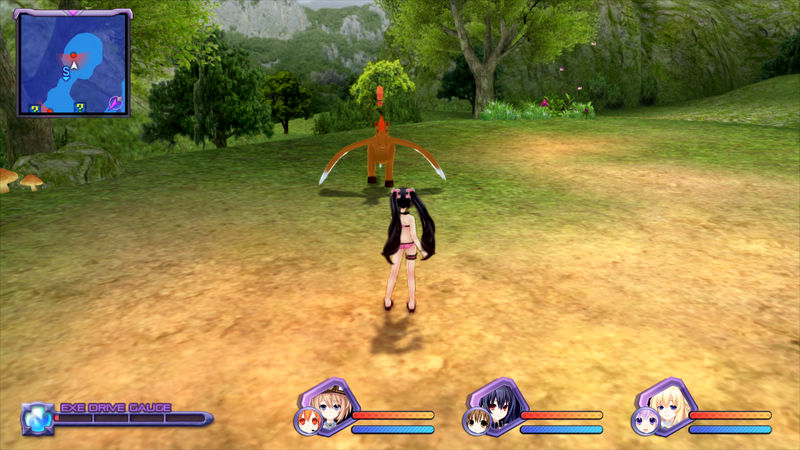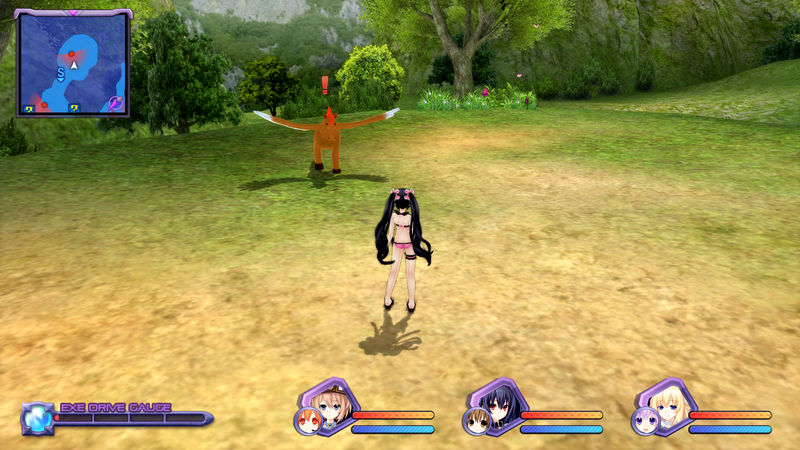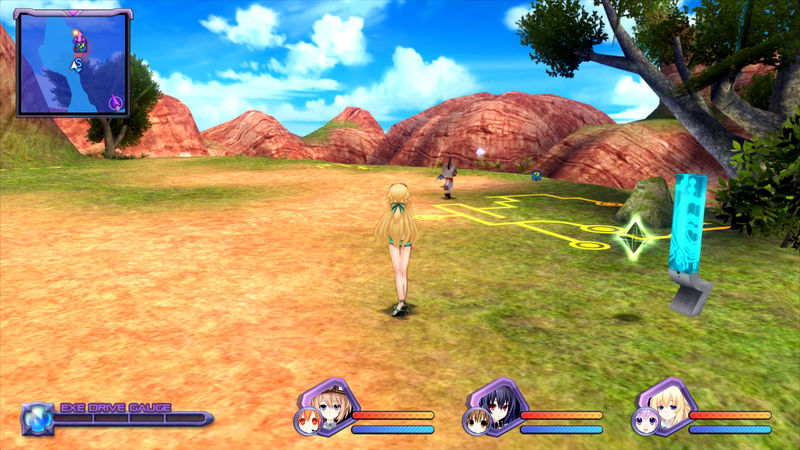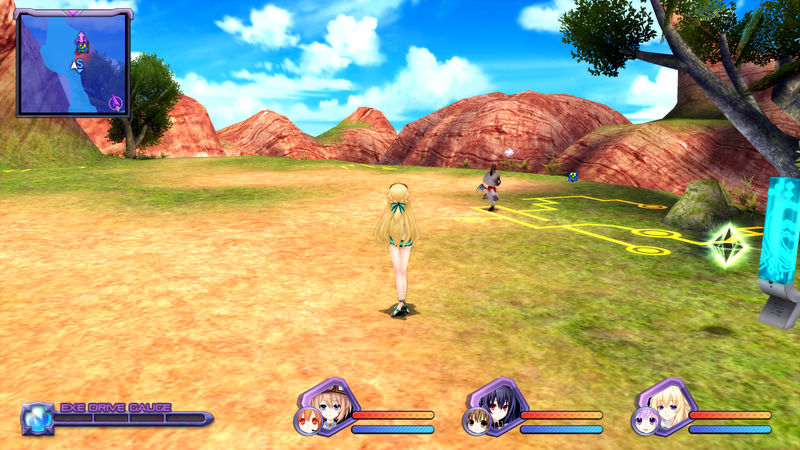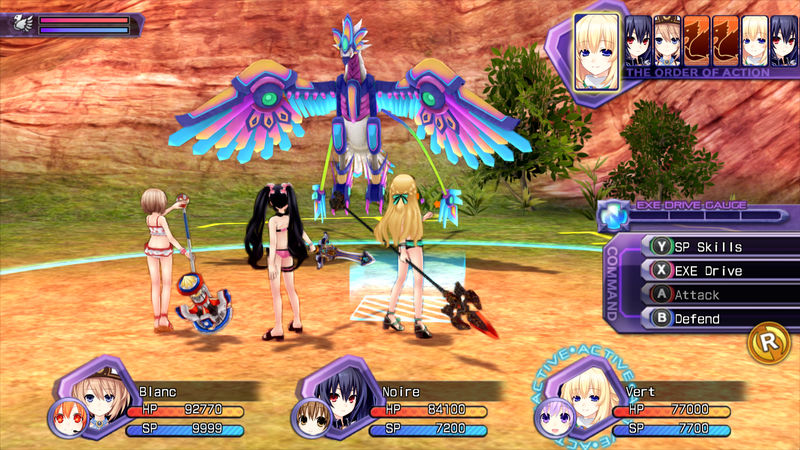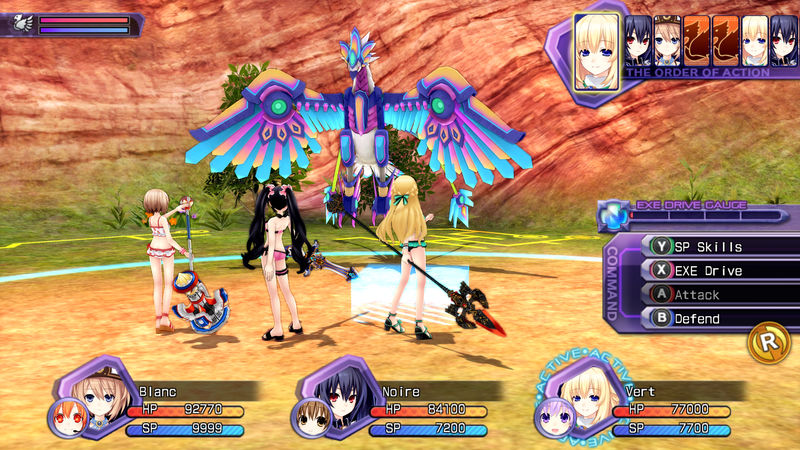Hyperdimension Neptunia Re;Birth1 is one of those weird Japanese games. It has a dating sim interface, ludicrous worldbuilding, anime-style underage cute girls, some scenes of pure fan service and a turn-based battle system. If you’re on this type of thing, continue on reading, if not, you’ve been warned.
The game was originally released on the PlayStation Vita in October 2013, and later on PCs in January 2015. It’s a remake of Hyperdimension Neptunia, a PlayStation 3 exclusive from 2010. While previously developed by Idea Factory and Compile Heart, Neptunia’s remakes were created by Felistella. From what I’ve found, Re;Birth1’s story is somewhat different from the original, with only a few central plot points preserved. It also incorporates mechanics from its sequels, making it a nice starting point for new players.
The Narrative
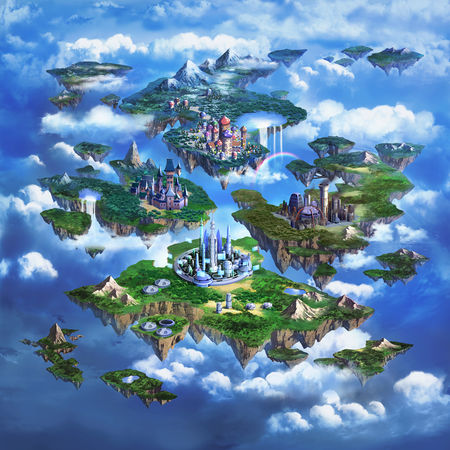
Based on real life events, the game takes place in Gameindustri, a dimension comprised of five floating islands, each protected by a goddess: Planeptune, protected by Neptune (or Purple Heart); Lastation, protected by Noir (or Black Heart); Leanbox, protected by Vert (or Green Heart); and Lowee, protected by Blanc (or White Heart). The fifth land is named Celestia and is where the goddesses reside. The four are known as Console Patron Units, or CPUs for short. Besides taking care of their nation and its people, the four keep fighting each other for the control of Gameindustri, a conflict called “The Console War”.
The game starts amidst a battle between the four goddesses when a mysterious voice says they should join forces against one of them to break their stalemate. Purple Heart is chosen as the target and is defeated by the others. Yes, they never thought about it and yes, they aren’t very bright.
Neptune falls from Celestia and crash-lands in Planeptune, transforming into a young girl on her way down. While unconscious, she’s contacted by a sentient book that registers the history of Gameindustri called Histoire (in French), who asks for her help. As their chat abruptly ends, the now amnesic Neptune is rescued by a girl named Compa.
After receiving fan-service medical aid, Neptune and Compa go investigate the game’s first dungeon. During the boss fight, Neptune transforms into a more powerful form and beats the monster. For their victory, they find a Key Fragment. Histoire explains that she’s trapped and needs three more of these items to be released. In exchange, she will help Neptune to recover her lost memories.
Before looking for the next Key Fragment, the girls take a job at the local guild to investigate a cave infested by monsters. While exploring the place they meet their third party member, a girl called IF. The three are attacked by the mysterious character from the game’s introduction, who wishes to absorb Neptune’s power. After the fight, we discover her name is Arfoire (also in French) and she’s the game’s true villain.
From now on Neptune must travel to the other lands to recover the rest of the Key Shards, retrieve her memories and recruit her fellow goddesses (and a legion of girls) to beat Arfoire and save all Gameindustri.
That was a lot to unpack.
The story isn’t long, as it’s divided in only eight medium-sized chapters. Most of them have Neptune visiting a different nation of Gameindustri and helping the local CPU deal with Arfoire’s newest plan. The story also lacks depth, as most of its themes, like friendship, going forward, being who you really are, don’t have any interesting nor original development.
But let’s be real, no one will think about playing a game called Hyperdimension Neptunia; Rebirth1 for its gripping plot. Probably its biggest attraction on the narrative front is its main characters. But not because they’re well-developed and have a memorable journey, but because they’re cute, dorky, and sometimes, genuinely funny. I love them.
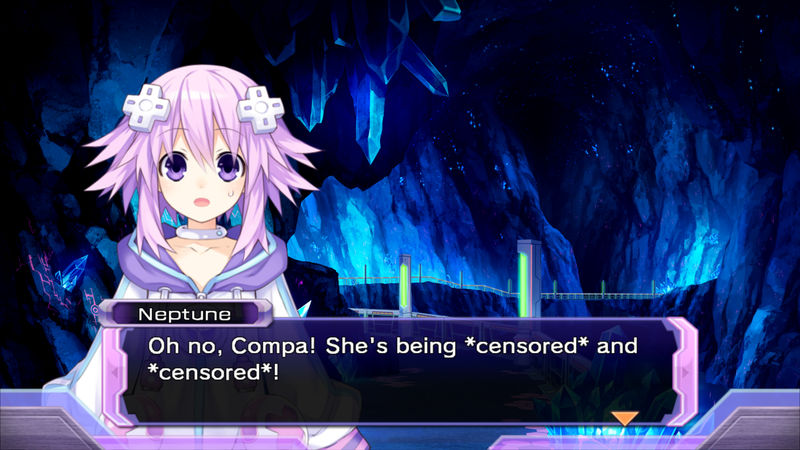
The dialogue is comprised most of jokes, quips and self-referential humor, with the occasional information dump. It gave me some chuckles, but don’t expect to enjoy it if you’re not into anime-like writing. If you are, the game is a lot of fun, with lots and lots of lines of dialogue.
On a positive note, I enjoyed the worldbuilding. Transforming the real-world console wars into a fight between deities is a ludicrous yet fun concept that you usually only see in Japanese media. If you don’t know much about the story of video games, a console war is the struggle for market dominance between platform makers. The game depicts past and present companies as the different nations of Gameindustri and its CPUs as their consoles:
- Planeptune: represents Sega.
- Lastation: represents Sony.
- Leanbox: represents Microsoft.
- Lowee: represents Nintendo.
Interestingly, Neptune’s name comes from an unreleased Sega console, the Sega’s Neptune. You can read more about it here.
Presentation
Neptunia’s first adventure on the PC market isn’t very impressive from a visual standpoint. As standard for JRPGs since the PlayStation 2 era, story segments are presented similarly to an Adventure/Dating Sim game, with just artwork of the characters involved in the scene, a text box and the dubbed dialogues. Dungeons and other areas with enemies feature scenarios and characters modeled in three dimensions. They aren’t as attractive as their two-dimensional counterparts, and are more akin to a middle-of-the-road PlayStation 3 game.
The artwork from story segments is beautiful, even if it doesn’t look as sharp as I would like. Something that adds a lot of charm to these moments is how the characters’ portraits move. They breathe, their hair seems as if being blown by wind, their lips move while speaking, and sometimes their face shows different types of emotion.
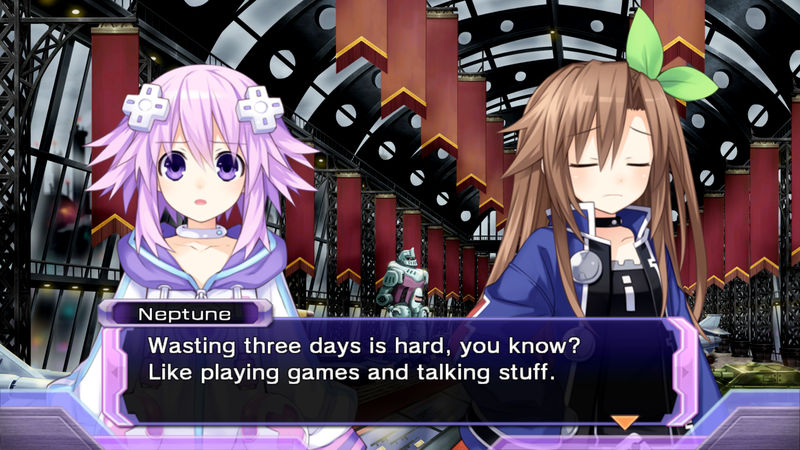
The fan-service artwork spread throughout the game is very good, if you are a person of culture.
There is a decent variation of dungeon to explore, like volcanic bases, mountain passes, abandoned ruins, factories, etc. Nonetheless they all are bland and uninteresting. They aren’t ugly, just there is nothing noteworthy about them. No special set piece or intricate design, neither intriguing puzzles.
A nice touch that you rarely see on turn-based RPGs is the presence of enemies on the screen. They will be there no matter how big they are. There is some variation to their designs, ranging from joke monsters, generic 3d robots and some creative ones.
As for characters’ models, they’re well made and are very cute. Thankfully, they don’t have that lifeless doll expression some 3d anime have. If you aren’t satisfied with your party’s looks, there are a lot of clothes and accessories to customize its appearance.
While exploring dungeons and similar locations, only the first character from your party will appear on-screen, but if you buy the Tag Along DLC you can have the other two members follow you. That’s a shameful scam. Even if it’s cheap, it should have been a free update, not a paid DLC. From reviews on Steam, it can be pretty buggy, with characters frequently getting stuck around corners and jumping like there is no tomorrow.
Unfortunately, everything during the 3d segments looks blurred, and there are no video options to solve it. But if you’re more demanding with your graphics and want them crisp, fear not. There is a mod called Neptastic Mod that dramatically improves the visuals (I’m not exaggerating). Don’t play the game without it!
Thanks to the mod, you can even play in 4K resolution (what I used while taking the screenshots). It also works on Re;Birth2 and Re;Birth3. Please don’t use Hyperresolution Neptunia, as it doesn’t work very well anymore and has less options than Neptastic.
You can choose between Japanese and English dubs, but per tradition I played with the Japanese one. It sounds very good and the actresses match their roles very well.
The soundtrack fits the lighthearted tone of the game. However, I didn’t care for it while doing my playthrough. No song caught my attention and had me wanting to go back or to prolong my stay just to keep hearing it. I didn’t think the songs were terrible or anything, just serviceable. But then I listened to them without playing, and I’m sorry for those who enjoy the soundtrack, but I think it’s awful. The game genuinely deserved a better, more varied set of songs. However, if you liked it, the PC has a paid DLC that comes with 29 tracks. I believe it’s the complete soundtrack, but it may be missing a song or two.
Mechanics
Again, the game is very similar to how JRPGs play since the PlayStation 2 era: no overworld to traverse or roam, only a hub screen where you can choose what to do and where to go. By selecting cities you can shop, listen to the soundtrack and look at artwork at the Museum, take part in special events or in compulsory story scenes, and use the guild. In the guild it’s possible to accept missions that revolve around defeating enemies or bringing back the items they leave for rewards. Some assignments are also necessary to progress the game’s plot. More options will be available later on, like the Colosseum, where you can fight high level enemies, and the CPUs’ blogs.
When you enter a dungeon or similar area, you will be able to freely roam through it. It’s possible to jump to reach some higher places, emit a Treasure Search wave to find invisible treasures, and do an attack. If you strike an enemy, you will gain the initiative in battle (the game calls it Symbol Attack). If they touch you first, they will gain the initiative (a Surprise Attack).
Battle System
The battle system isn’t deep in the sense that it has a lot of intricacies, but has many different and useful parts that make fighting a fun experience.
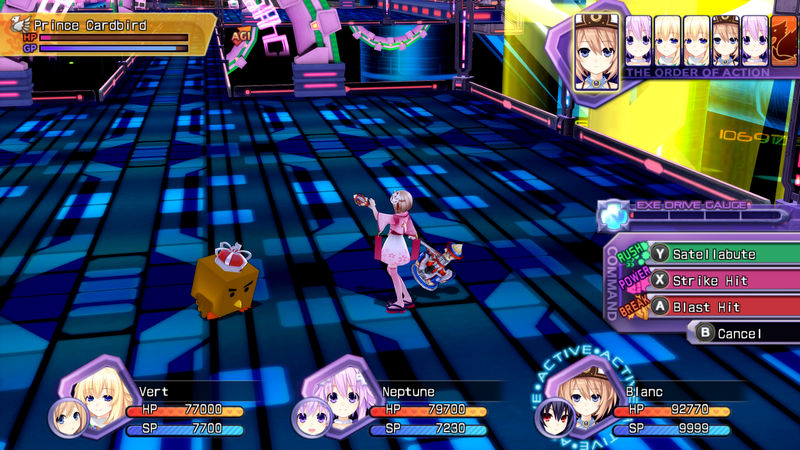
The game employs a turn-based battle system in which your three active party members can freely move throughout the battlefield’s map. As all forms of attack have an area of effect, movement adds a strategic element to every fight, since you need to think where your character should be to inflict more damage and receive less. You can keep an eye on the attack order by looking at the upper right corner of the screen.
Before starting a battle, it’s advisable to set up your Combo Skills and Ex Finishers on the Commands menu. Combo skills are how the game calls your common attacks, while Ex Finishers are special attacks that you can utilize at the end of your attack string if your EXE Drive Gauge is filed up. There are three types of Combo Skills, each with their unique effect:
- Rush: more hits but deals less damage; useful to increase the EXE Drive Gauge faster.
- Power: less hits but deals more damage to the adversary’s HP.
- Break: deals less damage to HP but depletes the enemies Guard Points bar faster, speeding Guard Breaks. While that status lasts, you will inflict more damage to your foes.
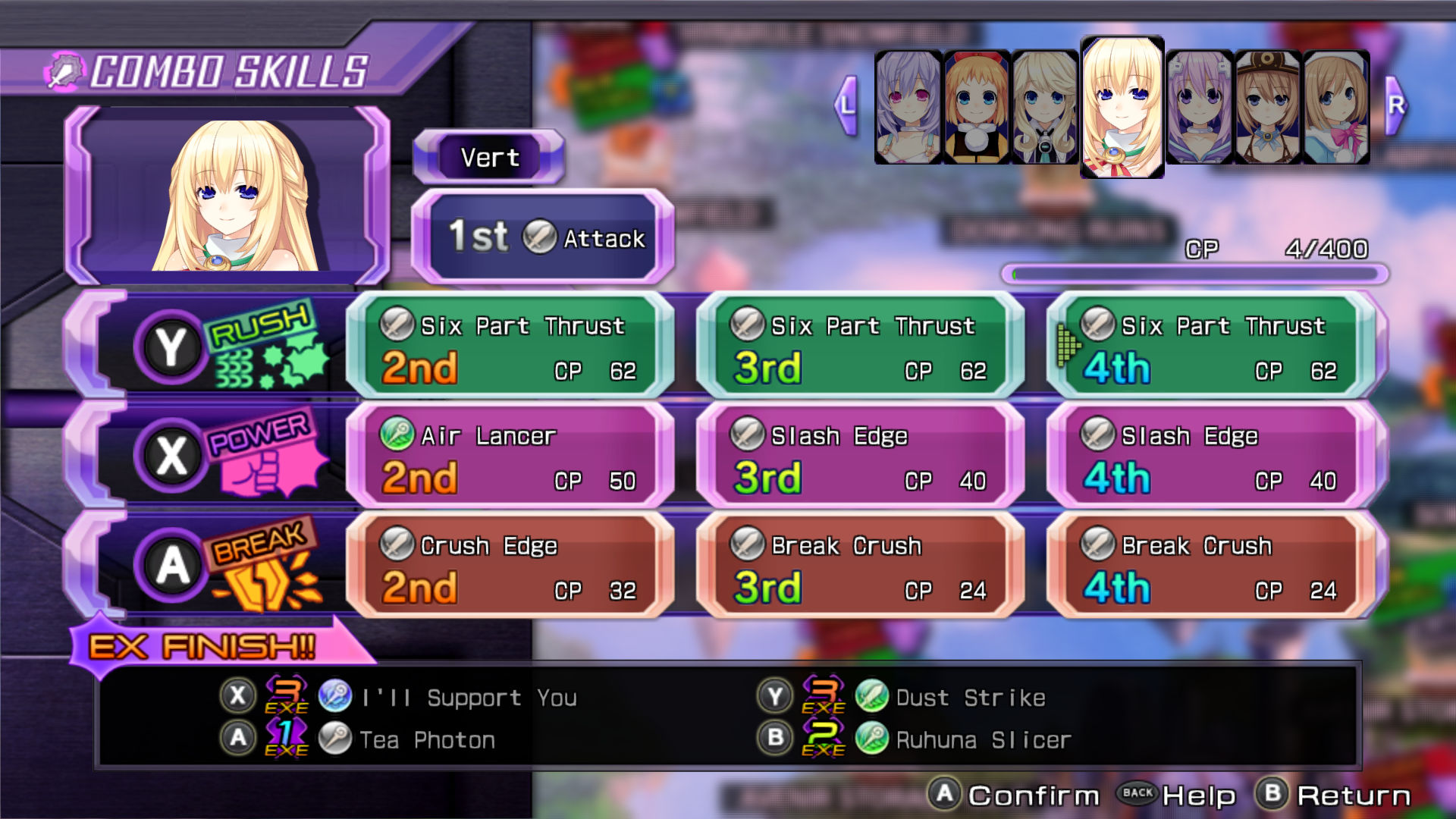
During a standard turn, you can choose three moves for each type of combo skill, and then four more finishers. In other words, each character can have up to 13 distinct attacks available. So if you choose the Attack option, you will:
- hit the enemy with a physical attack;
- then you must choose between a Rush, Power or Break attack
- repeat the last step two more times;
- unleash your Ex Finisher.
It may appear long and cumbersome to keep navigating so many menus, but as each Combo Skill is mapped to a specific button it’s easy to deliver a fast barrage of attacks.
As characters level up, they will gain more Combo Skills. Some are just stronger than older ones, others have unique effects or properties. It’s up to you to experiment and choose the most appropriate.
There are two more forms of attacks: SP Skills, your run of the mill, attack, heal and support abilities. There are also Exe Drive Skills, special skills that requires that you fill something called the EXE Drive Gauge.
The Exe Drive Gauge
Filling the Exe Drive Gauge is necessary to use Ex Finishers and Exe Drive Skills. It will slowly build up every time you attack or is attacked. However, it’s possible to speed it up a lot by using Rush attacks. If the meter is over a set level you will be able to utilize EX Finishers as the last action of a combo. It also unlocks the use of Exe Drive Skills. These skills are stronger than SP Skills but they will deplete the Exe Drive Gauge, so they’re better reserved for stronger enemies. Like Combo Skills, Ex Finishers and Exe Drive Skills are usually acquired by gaining levels.
Hard Drive Divinity
An exclusive feature of the CPUs is their ability to sacrifice 20% of their max SP to transform into a more powerful form called Hard Drive Divinity (HDD). This is the same form they had during their fight in the beginning of the game. Unfortunately, it’s just an elaborate status boost. Nonetheless, they’re very good for tougher battles.
Lily System
This mechanic allows players to pair an active party member with an idle character. Partnered characters will gain new passive abilities (more EXP, less waiting time between turns, less SP for skills, etc.), new Ex Finishers and new Exe Drive Skills. But these skills are acquired only when their level of affinity, or Lily Rank, reaches a certain level. The more battles two characters fight teamed up, the more their Lily Rank increases. Another benefit is being able to swap between paired characters throughout combat. It’s like having a backup team in case your party is about to die.
Other stuff
Remake System
If you like crafting, the Remake System will be a lot of fun for you. By utilizing different Plans it’s possible to modify certain elements from the game (like EXP received, jump height, how strong enemies are, etc.) or add new items, equipment, monsters and even dungeons.
To create a Plan, first it’s necessary to acquire Plan itself from enemies or on special events. Next, harvest the required materials. Lastly, if you have enough “memory available”, then you can finally develop it. You don’t need to use the Remake System to finish the main story, but it adds a good ammount of optional content to give you more gameplay time. Exploring extra dungeons and acquiring new items and equipment may be a good distraction if you ever need to grind.
DLC
Unfortunately, the game has a lot of content locked behind paid DLC (I think it’s a lot, I don’t have a high tolerance for this type of situation). Level caps, additional characters, new dungeons, a film theater function, the option to have more than one character on the map, and the list goes on. It leaves a sour taste when you need to pay more for so little content.
Final Thoughts
I enjoyed the game, yet it’s hard to recommend it for everyone. The setting is great, however it’s a novelty that won’t carry you for long. The story is simple and won’t surprise you in any way (just another “let’s save the world”). For those that dislike anime tropes, characters may seem annoying or cliché, but they have some charm and I won’t lie that I loved some of these dorky people from Gameindustri.
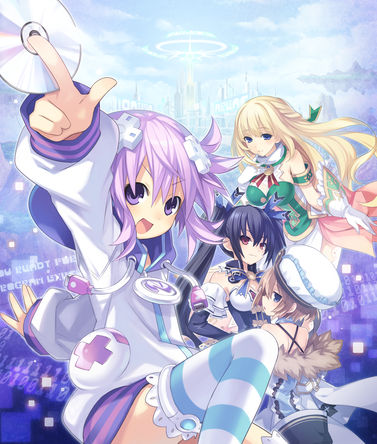
There are some complaints about how the fan service and the character designs are sexist (which they are). Despite sexism being a valid critique against Japanese media as a whole, the game has many redeeming aspects, like how its world is governed by four women, a rarely seen all-female main cast, main characters have different personalities, passions and hobbies (none that involves a man). Either way, I think the game has considerably more to offer than just fan service and deserves a fair chance.
On the technical front, I enjoyed how battles flowed but was unsatisfied by the lack of exploration. I saw some complaints about the game being grindy in some sections, but I never felt it (maybe I fought too much). If you enjoyed the battle system, there are a lot of optional dungeons to complete (unfortunately some are paid DLC) and the Colosseum, where you can fight to your heart’s content.
In the end, I wouldn’t recommend this game if you can’t stand anime tropes and simple writing. I wouldn’t also recommend it if you’re against buying products from companies that release predatory DLC. But if you are into weird Japanese curiosities and enjoy JRPGs and anime, the game is for you.
Final opinion: Recommend only for anime fans, people who like silly and light-toned stories, and logically, for people of culture.

